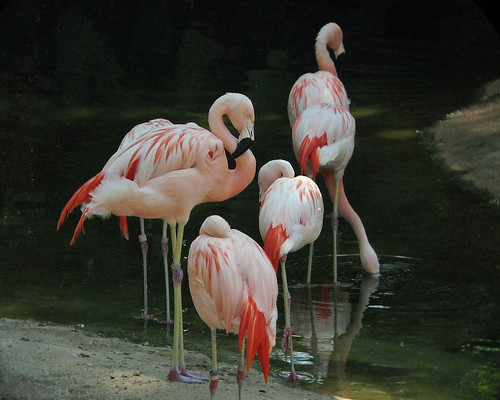
Six flamingos, Phoenicopterus ruber,
bored with people-watching at the Caldwell Zoo in Tyler, Texas.
(Can you see all six birds?)
Image appears here with the kind permission of the photographer, Michael C. Hamilton (contact).
Birds in Science
A new study of global avian biodiversity published in the free open access journal, PLoS Biology, provides the first strong evidence that avian species' range areas are smallest in the tropics and larger in temperate and polar regions. A smaller range area means that many different types of creatures can be accommodated in the same space, explaining why regions such as the Amazon Basin contain such a rich variety of species. Conversely, temperate areas, such as North America, contain a smaller number of different species since large range areas mean fewer species can co-exist. This study could play a key role in identifying which species are most vulnerable to extinction, researchers report.
People Hurting Birds
This is a story about an island ecosystem, Great Guana Cay, in the West Indies, that is occupied by birds, fish and marine invertebrates. Basically, a lot of things are happening at Great Guana Cay: A lot of controversial things. At the center of this raging debate is an admirable young marine ecologist named Kathleen: a good scientist whose life's work is centered on conservation and the impact of developments on tropical eco-regions. Under normal circumstances, this might be the beginning of a nice environmental article about a young, energetic woman saving fish (well, and birds). But it is much more complicated than that. You can access the ongoing saga of this story by exploring the links found in the site's left sideboard.
In the past six weeks, dozens of birds have met their deaths after flying into an expansive wall of glass at Johnson County's Sunset Drive building in Olathe, Kansas. It's no small irony that this occurred at the county's "green" office building -- unveiled in February as a cutting-edge example of man in harmony with nature. The building's southern exposure reflects the neighboring woods, and birds see it as fly-through territory -- an extension of their natural habitat. "It's a senseless and preventable slaughter," said Daniel Klem Jr., ornithology and conservation professor at Muhlenberg College in Allentown, Pennsylvania. With at least a billion feathered casualties each year, glass ranks second only to habitat loss as the leading cause of premature avian deaths, said Klem. By comparison, hunters annually shoot an estimated 120.5 million birds, and research data suggest that domestic cats kill up to a billion more each year. Frank Gill, chief scientist for the National Audubon Society, said bird collisions are an unappreciated phenomenon that his organization is now exploring. This article also includes strategies for making windows more visible to birds.
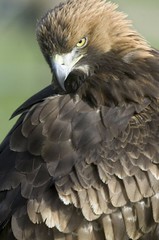 In the UK, a rare golden eagle, Aquila chrysaetos (pictured), was deliberately poisoned in an attempt to protect grouse, it was recently reported. The body of the protected bird was discovered by a hillwalker on a Royal Deeside grouse moor and experts said the killing will affect eagle breeding in Scotland for years. Tests have confirmed that the body contained traces of carbofuran, a pesticide that is banned in the UK. "In this case, the poison is totally banned from use and it's an offence to even possess it," said Dave Dick, a senior investigations officer with the Royal Society to Protect Birds, or RSPB. Under the Nature Conservation (Scotland) Act 2004, poisoning birds of prey can carry a six-month jail sentence or a £5,000 fine. [Image: The Falconry Centre]
In the UK, a rare golden eagle, Aquila chrysaetos (pictured), was deliberately poisoned in an attempt to protect grouse, it was recently reported. The body of the protected bird was discovered by a hillwalker on a Royal Deeside grouse moor and experts said the killing will affect eagle breeding in Scotland for years. Tests have confirmed that the body contained traces of carbofuran, a pesticide that is banned in the UK. "In this case, the poison is totally banned from use and it's an offence to even possess it," said Dave Dick, a senior investigations officer with the Royal Society to Protect Birds, or RSPB. Under the Nature Conservation (Scotland) Act 2004, poisoning birds of prey can carry a six-month jail sentence or a £5,000 fine. [Image: The Falconry Centre]
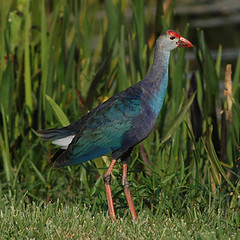 The non-native purple swamphen, Porphyrio porphyrio (pictured), which is quickly gaining prominence in Palm Beach County wetlands, has some environmentalists worrying about its international reputation for eating bird eggs and ducklings. Although experts estimate less than 1,000 purple swamphens live in South Florida, the bird's occasionally carnivorous tendencies have sparked fears that it will threaten native water fowl. And in the past few years it has been spotted for the first time in Palm Beach County. Purple swamphens resemble the native purple gallinules and moorhens found throughout South Florida, but they are larger and, for a lack of proper scientific term, more chicken-esque. They are found all over the world, from Europe to Asia and New Zealand. But a colony had never been spotted in the wild in North America until the 1990s, when dozens were reported to be roosting in Pembroke Pines in Broward County. "They're an issue of concern," said Ellen Donlan, a staff environmental scientist at the South Florida Water Management District. "We don't know much about how they behave here, but we do know that in their natural range they are a threat to other birds." [Image: Larry Manfredi]
The non-native purple swamphen, Porphyrio porphyrio (pictured), which is quickly gaining prominence in Palm Beach County wetlands, has some environmentalists worrying about its international reputation for eating bird eggs and ducklings. Although experts estimate less than 1,000 purple swamphens live in South Florida, the bird's occasionally carnivorous tendencies have sparked fears that it will threaten native water fowl. And in the past few years it has been spotted for the first time in Palm Beach County. Purple swamphens resemble the native purple gallinules and moorhens found throughout South Florida, but they are larger and, for a lack of proper scientific term, more chicken-esque. They are found all over the world, from Europe to Asia and New Zealand. But a colony had never been spotted in the wild in North America until the 1990s, when dozens were reported to be roosting in Pembroke Pines in Broward County. "They're an issue of concern," said Ellen Donlan, a staff environmental scientist at the South Florida Water Management District. "We don't know much about how they behave here, but we do know that in their natural range they are a threat to other birds." [Image: Larry Manfredi]
People Helping Birds
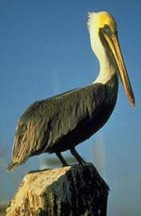 People are helping to rehabilitate brown pelicans, Pelecanus occidentalis (pictured), that are inexplicably starving so they are easily picked off the beaches of California. I wonder; why are these birds are starving??
People are helping to rehabilitate brown pelicans, Pelecanus occidentalis (pictured), that are inexplicably starving so they are easily picked off the beaches of California. I wonder; why are these birds are starving??
Also in the news was a dramatic rescue of a newly-fledged osprey, Pandion haliaetus, whose foot was caught in a wire at the top of an 85-foot light pole on the Mesa College campus in California. After dangling upside down for five hours, the bird was rescued by utility workers and a wildlife expert, who determined the bird had a badly fractured leg and is now in the care of wildlife rehabilitation center. "I feel like it is one of my kids. We are very attached to our osprey," said Dave Evans, dean of physical education, health, dance and athletics at the college. "I'm relieved that we got the bird," said Chuck Traisi, who operates the Fund for Animals Wildlife Rehabilitation Center in Ramona. "Now we can focus all of our attention to the bird's medical condition."
A rescued bald eagle, Haliaeetus leucocephalus, found starving in a field in Douglas County two weeks ago, has been crying out a few high-pitched barks the last few days - a sure sign the eagle is recovering. Only two weeks ago, two boys were crossing a pasture near their father's farmhouse south of Garret and west of Tuscola in central Illinois state to feed their ponies when they saw the bird. They were able to inch up to within 10 feet of the bird, and excitedly went back home to tell their parents and some neighbors. "She's a really big bird. She's starting to calm down a great deal," said Jacques Nuzzo of the Illinois Raptor Center. "It's going to take a while, but I really think that she's going to be a neat bird."
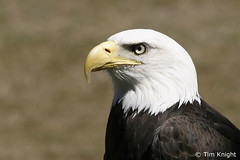 In June 1997, a bald eagle, Haliaeetus leucocephalus, took its first flight from a nest in Greene County, New York. It has been more than 100 years since the last successful eagle fledge along Hudson Valley tidewater. They had suffered through a century of public apathy, habitat loss and, along with other raptors, the toxic repercussion Rachel Carson decried in her 1962 book, Silent Spring. But thanks to efforts to identify, preserve and protect eagle habitat, and ensure their welfare, there are approximately a dozen eagle nests along the Hudson River. All of the nests are north of the Tappan Zee Bridge and south of Albany, and most are in out-of-the-way areas. This is a mixed blessing. Though privacy is essential, bald eagle behavior in the rearing of their nestlings is one of the most fascinating shows in nature, and people protect wild animals whom they care about most. [Image: Tim Knight]
In June 1997, a bald eagle, Haliaeetus leucocephalus, took its first flight from a nest in Greene County, New York. It has been more than 100 years since the last successful eagle fledge along Hudson Valley tidewater. They had suffered through a century of public apathy, habitat loss and, along with other raptors, the toxic repercussion Rachel Carson decried in her 1962 book, Silent Spring. But thanks to efforts to identify, preserve and protect eagle habitat, and ensure their welfare, there are approximately a dozen eagle nests along the Hudson River. All of the nests are north of the Tappan Zee Bridge and south of Albany, and most are in out-of-the-way areas. This is a mixed blessing. Though privacy is essential, bald eagle behavior in the rearing of their nestlings is one of the most fascinating shows in nature, and people protect wild animals whom they care about most. [Image: Tim Knight]
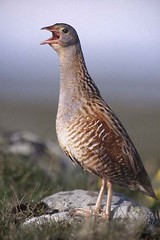 The peculiar corncrake, Crex crex (pictured), the world's most threatened bird to breed regularly in the UK is recovering due to conservation efforts, and there is good news about other species as well, according to a report published by the government on behalf of the UK Biodiversity Partnership today. The partnership reports on a three year cycle. While gains are apparent, the report cites current or emerging threats such as global warming and habitat loss and degradation due to development. Corncrakes are related to moorhens, coots and rails but live on dry land, mostly in Britain's western islands and in Scotland. The secretive birds are migratory; wintering in Africa, and breeding in the UK, hidden in tall grasses and corn, and can be located by their rasping call, crek-crek. [Image: A Rocha International]
The peculiar corncrake, Crex crex (pictured), the world's most threatened bird to breed regularly in the UK is recovering due to conservation efforts, and there is good news about other species as well, according to a report published by the government on behalf of the UK Biodiversity Partnership today. The partnership reports on a three year cycle. While gains are apparent, the report cites current or emerging threats such as global warming and habitat loss and degradation due to development. Corncrakes are related to moorhens, coots and rails but live on dry land, mostly in Britain's western islands and in Scotland. The secretive birds are migratory; wintering in Africa, and breeding in the UK, hidden in tall grasses and corn, and can be located by their rasping call, crek-crek. [Image: A Rocha International]
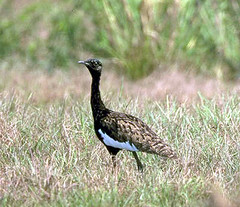 Recently, a comprehensive survey for grassland bird species was jointly conducted by BirdLife and the Wildlife Conservation Society (WCS) in provinces surrounding the Tonle Sap lake, Cambodia. Information gained during the survey will be a foundation for locating critical habitats for these species in Cambodia. Bengal Floricans, Eupodotis bengalensis (pictured), are one grassland species surveyed. They are found only in India, Nepal, Vietnam and Cambodia. They are listed as Endangered on the IUCN Red List and face a very high risk of extinction in the medium term future. Cambodia is suspected to hold the largest surviving population.
Recently, a comprehensive survey for grassland bird species was jointly conducted by BirdLife and the Wildlife Conservation Society (WCS) in provinces surrounding the Tonle Sap lake, Cambodia. Information gained during the survey will be a foundation for locating critical habitats for these species in Cambodia. Bengal Floricans, Eupodotis bengalensis (pictured), are one grassland species surveyed. They are found only in India, Nepal, Vietnam and Cambodia. They are listed as Endangered on the IUCN Red List and face a very high risk of extinction in the medium term future. Cambodia is suspected to hold the largest surviving population.
 Hunting and the destruction of forests have put many of Madagascar's rare bird species on the endangered list, but the government's drive to protect habitat may turn the tide, a leading scientist said. The wildlife of the huge Indian Ocean Island will be in the spotlight on Tuesday at the start of a major conservation conference that will examine ways to link Africa's natural treasures to poverty alleviation. Madagascar (red square on map) is a paradise for bird lovers, with around 120 species that are found nowhere else. But about one quarter of these types of birds are endangered. "There is hope. The rate of deforestation has slowed," said Frank Hawkins, an ornithologist and co-author of the main field guide on birds of Madagascar. [Image: Nations Online]
Hunting and the destruction of forests have put many of Madagascar's rare bird species on the endangered list, but the government's drive to protect habitat may turn the tide, a leading scientist said. The wildlife of the huge Indian Ocean Island will be in the spotlight on Tuesday at the start of a major conservation conference that will examine ways to link Africa's natural treasures to poverty alleviation. Madagascar (red square on map) is a paradise for bird lovers, with around 120 species that are found nowhere else. But about one quarter of these types of birds are endangered. "There is hope. The rate of deforestation has slowed," said Frank Hawkins, an ornithologist and co-author of the main field guide on birds of Madagascar. [Image: Nations Online]
Endangered Bird News
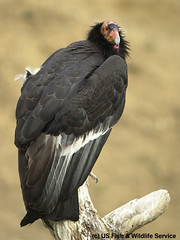 Wildlife officials set traps in the Pinnacles state park in California for California condors, Gymnogyps californianus (pictured), so they can test the birds for lead poisoning after many were spotted feeding on squirrels that had been shot. Even microscopic lead traces from ammunition can paralyze digestive systems in the endangered species and cause the birds to starve to death, park officials said. The traps were laid over the weekend after 11 of the park's 13 condors were seen feeding on the squirrel carcasses, said Denise Louie, the park's chief of natural resources. "We don't know who shot the rodents or why," Louie said. "If rodents have to be shot, maybe their carcasses can be buried to protect not only condors but other carrion eaters and raptors." [Image: USFWS]
Wildlife officials set traps in the Pinnacles state park in California for California condors, Gymnogyps californianus (pictured), so they can test the birds for lead poisoning after many were spotted feeding on squirrels that had been shot. Even microscopic lead traces from ammunition can paralyze digestive systems in the endangered species and cause the birds to starve to death, park officials said. The traps were laid over the weekend after 11 of the park's 13 condors were seen feeding on the squirrel carcasses, said Denise Louie, the park's chief of natural resources. "We don't know who shot the rodents or why," Louie said. "If rodents have to be shot, maybe their carcasses can be buried to protect not only condors but other carrion eaters and raptors." [Image: USFWS]
 The reintroduction of the flightless Campbell Island Teal, Anas nesiotis (pictured), to its sub-Antarctic home in 2004, after more than a century of exile, was carried out successfully. But could they survive the harsh climate that was new to these captive and New Zealand-raised ducks, and equally importantly, would they breed? In February 2005 a monitoring team from New Zealand's Department of Conservation (DOC) found 78% of the transferred teal alive, but no ducklings. This was disappointing as they had bred in their first year when transferred from captivity to Whenou Hou (Codfish Island), a rat-free island off Stewart Island (a large island off the southern tip of NZ's South Island). But in the end, it wasn't a teal-monitoring team that saw the first teal ducklings ever seen on Campbell Island, but an albatross research team. A brood of small ducklings and their parents were sighted swimming by the wharf at Beeman Base in January 2006. This sighting was followed up in February by a teal monitoring team who, with the assistance of Percy the dog, found one small duckling with a female teal, three juveniles and two nests containing eggs. [Image: Department of Conservation, New Zealand]
The reintroduction of the flightless Campbell Island Teal, Anas nesiotis (pictured), to its sub-Antarctic home in 2004, after more than a century of exile, was carried out successfully. But could they survive the harsh climate that was new to these captive and New Zealand-raised ducks, and equally importantly, would they breed? In February 2005 a monitoring team from New Zealand's Department of Conservation (DOC) found 78% of the transferred teal alive, but no ducklings. This was disappointing as they had bred in their first year when transferred from captivity to Whenou Hou (Codfish Island), a rat-free island off Stewart Island (a large island off the southern tip of NZ's South Island). But in the end, it wasn't a teal-monitoring team that saw the first teal ducklings ever seen on Campbell Island, but an albatross research team. A brood of small ducklings and their parents were sighted swimming by the wharf at Beeman Base in January 2006. This sighting was followed up in February by a teal monitoring team who, with the assistance of Percy the dog, found one small duckling with a female teal, three juveniles and two nests containing eggs. [Image: Department of Conservation, New Zealand]
Birds and Wind Power
 A recent edition of The Morning Call (Allentown, PA USA) includes an Op-Ed piece about birds and industrial-sized wind energy facilities on the forested Appalachian ridges of Maryland, Pennsylvania, Virginia, and West Virginia. It was written by one of my readers. Personally, I am "sitting on the fence" with regard to wind farms because I have not investigated this issue very much yet. This piece did nothing to change my firmly uncommitted stance because it did not cite specific data, but I am open to other reader comments (and particularly research data) on this issue. Windfarming will only become more important as time goes on! [Image: STASYS]
A recent edition of The Morning Call (Allentown, PA USA) includes an Op-Ed piece about birds and industrial-sized wind energy facilities on the forested Appalachian ridges of Maryland, Pennsylvania, Virginia, and West Virginia. It was written by one of my readers. Personally, I am "sitting on the fence" with regard to wind farms because I have not investigated this issue very much yet. This piece did nothing to change my firmly uncommitted stance because it did not cite specific data, but I am open to other reader comments (and particularly research data) on this issue. Windfarming will only become more important as time goes on! [Image: STASYS]
Controversy surrounding wind farming are occurring in other countries, too. The head of a Maori, New Zealand, incorporation proposing a 42-turbine wind farm near Kawhia rejected claims yesterday that the scheme should be turned down because 125m-high turbines could threaten birdlife. Taharoa C chairman, Monte Retemeyer, told an audience of about 60 people at the first day of a week-long local authority hearing in Te Kuiti that the wind farm would improve living standards for the 200-member Taharoa community. Ironsand mining carried out by New Zealand Steel that had supported the local economy since 1970 was expected to wind down, and another income source was needed, Retemeyer said. About 80 per cent of shareholding residents are set to profit if approval is granted to the incorporation to feed power into the national grid.
Endangered and Extinct Bird News
According to the IUCN Red List, 131 bird species have become extinct since 1500, with an additional four species surviving only in captivity and formally classified as Extinct in the Wild. But a new paper by BirdLife's Stuart Butchart and Alison Stattersfield, and Conservation International's Tom Brooks, argues that the number of recent extinctions documented by the Red List is likely to be "a significant underestimate." The paper, "Going or gone: defining 'Possibly Extinct' species to give a truer picture of recent extinctions" [PDF], published in The Bulletin of the British Ornithologists' Club, describes the method the authors developed to identify 15 Critically Endangered species as being Possibly Extinct.
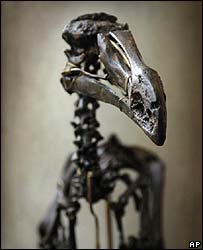 Scientists say they have discovered part of the skeleton of a dodo, Raphus cucullatues (pictured), the large, flightless bird which became extinct more than 300 years ago. One of the team in Mauritius said it was the first discovery of fully preserved bones which could give clues as to how the bird lived its life. No complete skeleton has ever been found in Mauritius, and the last full set of bones was destroyed in a fire at a museum in Oxford, England, in 1755. The find includes a complete hip and four leg bones (femur, fibula, tibiotarsus and hypotarsus). Numerous other dodo parts were also unearthed, such as skull fragments, beak bones, vertebrae, wing bones and toe bones. [Image: AP]
Scientists say they have discovered part of the skeleton of a dodo, Raphus cucullatues (pictured), the large, flightless bird which became extinct more than 300 years ago. One of the team in Mauritius said it was the first discovery of fully preserved bones which could give clues as to how the bird lived its life. No complete skeleton has ever been found in Mauritius, and the last full set of bones was destroyed in a fire at a museum in Oxford, England, in 1755. The find includes a complete hip and four leg bones (femur, fibula, tibiotarsus and hypotarsus). Numerous other dodo parts were also unearthed, such as skull fragments, beak bones, vertebrae, wing bones and toe bones. [Image: AP]
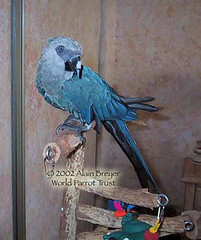 The Isabella Stewart Gardner Museum of art in Boston announced they are hosting an exhibition from June 30-September 17, that explores the tragic extinction from the wild of Spix's Macaw due to poaching and collecting. The Spix's Macaw, Cyanopsitta spixii, the world's rarest bird, is native to the rainforests of Brasil. The exhibition includes a visual and sound installation, and art by Swedish artist Henrik HÃ¥kansson, and it explores the profound loss society suffers through the extinction of a species. The exhibition will include an exceedingly rare specimen of the Spix's macaw, on loan from Harvard's Museum of Comparitive Zoology, and never before displayed outside their private collection. The story of the macaw, which only survives in private collections, is an important one, because it sheds light on some of the dark practices of poaching and smuggling exotic animals. [Image: Alain Breyer, World Parrot Trust]
The Isabella Stewart Gardner Museum of art in Boston announced they are hosting an exhibition from June 30-September 17, that explores the tragic extinction from the wild of Spix's Macaw due to poaching and collecting. The Spix's Macaw, Cyanopsitta spixii, the world's rarest bird, is native to the rainforests of Brasil. The exhibition includes a visual and sound installation, and art by Swedish artist Henrik HÃ¥kansson, and it explores the profound loss society suffers through the extinction of a species. The exhibition will include an exceedingly rare specimen of the Spix's macaw, on loan from Harvard's Museum of Comparitive Zoology, and never before displayed outside their private collection. The story of the macaw, which only survives in private collections, is an important one, because it sheds light on some of the dark practices of poaching and smuggling exotic animals. [Image: Alain Breyer, World Parrot Trust]
Avian Zoonotic News
 With regard to West Nile Virus (pictured), it turns out that American robins appear to be taking the hit for humans, getting sick and dying as did thousands of crows did a few years ago that were infected in the first wave of West Nile virus after it arrived in North America. Thanks to the robins, humans have a lower chance of contracting the virus, at least in spring and early summer months. The reason? To mosquitoes, robins are far more tempting meals. But then things change abruptly in autumn. "Robins begin to migrate south in late July and August," said infectious-disease ecologist Marm Kilpatrick, "leaving mosquitoes on the hunt for blood from another source." That source turns out to be Homo sapiens. Since it arrived in the United States in 1999, West Nile virus has become the major "vector-borne" disease here, with 826 reported deaths, 22,000 illnesses and "almost certainly a million people infected," said biologist Peter Daszak of the Consortium for Conservation Medicine in New York. Recent data suggest that the virus will cause 2,000 to 10,000 new U.S. cases a year, according to consortium reports. This research was published in the peer-reviewed journal, PLoS Biology [PDF; Image: Center for Disease Control, USA].
With regard to West Nile Virus (pictured), it turns out that American robins appear to be taking the hit for humans, getting sick and dying as did thousands of crows did a few years ago that were infected in the first wave of West Nile virus after it arrived in North America. Thanks to the robins, humans have a lower chance of contracting the virus, at least in spring and early summer months. The reason? To mosquitoes, robins are far more tempting meals. But then things change abruptly in autumn. "Robins begin to migrate south in late July and August," said infectious-disease ecologist Marm Kilpatrick, "leaving mosquitoes on the hunt for blood from another source." That source turns out to be Homo sapiens. Since it arrived in the United States in 1999, West Nile virus has become the major "vector-borne" disease here, with 826 reported deaths, 22,000 illnesses and "almost certainly a million people infected," said biologist Peter Daszak of the Consortium for Conservation Medicine in New York. Recent data suggest that the virus will cause 2,000 to 10,000 new U.S. cases a year, according to consortium reports. This research was published in the peer-reviewed journal, PLoS Biology [PDF; Image: Center for Disease Control, USA].
BirdNest Cams
Do you have a nestbox camera that you are monitoring? If so, you can submit your summary on each nestbox and nesting attempt online at Cornell University's Birdhouse Network.
Have you seen the latest? For almost a week now, many people have been enjoying views of a female Wood Duck incubating 10 eggs in Texas. The first egg was laid on May 28th, so expect to see ducklings sometime between the beginning to the middle of July.
Also; there's an Eastern Bluebird nest in Kentucky with eggs that will hatch any day now.
Five Tree Swallows hatched early last week in Oregon.
There's a Prothonotary Warbler nest under construction in Texas.
Streaming Birds
 This week on BirdNote, beginning on June 26: Monday, the drumming of the ruffed grouse, Bonasa umbellus; Tuesday, the hermit thrush, Catharus guttatus -- what a song!; Wednesday, the instrumental sounds that birds make: drumming, pounding, wing-noises, and more; Thursday "Ode to a Nightingale;" and Friday ... well... the calliope hummingbird. Yes, the calliope hummingbird was scheduled to appear on June 22, but the radio station mixed up the files and played a story about anting. So you'll find "Anting: Avian Spa Treatment" (with a most unusual photo) already on the web site in the archives. And "The Tiniest Bird on the Continent" will appear on Friday, June 30. BirdNotes transport the listener out of the daily grind with two-minute vignettes that incorporate the rich sounds of birds provided by Cornell University and by other sound recordists, with photographs and written stories that illustrate the interesting -- and in some cases, truly amazing -- abilities of birds. Some of the shows are Pacific Northwest-oriented, but many are of general interest. BirdNote can be heard live, Monday through Friday, 8:58-9:00AM in Western Washington state and Southern British Columbia, Canada, on KPLU radio and now also in North Central Washington state on KOHO radio. All episodes are available in the BirdNote archives, both in written transcript and mp3 formats, along with photographs. Listener ideas and comments are welcomed. [rss].
This week on BirdNote, beginning on June 26: Monday, the drumming of the ruffed grouse, Bonasa umbellus; Tuesday, the hermit thrush, Catharus guttatus -- what a song!; Wednesday, the instrumental sounds that birds make: drumming, pounding, wing-noises, and more; Thursday "Ode to a Nightingale;" and Friday ... well... the calliope hummingbird. Yes, the calliope hummingbird was scheduled to appear on June 22, but the radio station mixed up the files and played a story about anting. So you'll find "Anting: Avian Spa Treatment" (with a most unusual photo) already on the web site in the archives. And "The Tiniest Bird on the Continent" will appear on Friday, June 30. BirdNotes transport the listener out of the daily grind with two-minute vignettes that incorporate the rich sounds of birds provided by Cornell University and by other sound recordists, with photographs and written stories that illustrate the interesting -- and in some cases, truly amazing -- abilities of birds. Some of the shows are Pacific Northwest-oriented, but many are of general interest. BirdNote can be heard live, Monday through Friday, 8:58-9:00AM in Western Washington state and Southern British Columbia, Canada, on KPLU radio and now also in North Central Washington state on KOHO radio. All episodes are available in the BirdNote archives, both in written transcript and mp3 formats, along with photographs. Listener ideas and comments are welcomed. [rss].
Miscellaneous Bird News
The driver was sober. But the bird he hit may have been under the influence. A brown pelican, Pelecanus occidentalis, flew through the windshield of a motorist on the Pacific Coast Highway in Orange County, California, last Thursday, and wildlife officials said the bird was probably intoxicated by a chemical in the water (AP video: 62 seconds). Even though toxicology tests take several weeks, the odd bird behavior is thought to be the result of poisoning from domoic acid, which has been found in the ocean in the area, said Lisa Birkle, assistant wildlife director at the Wetlands and Wildlife Care Center in Huntington Beach.
There's a new CD containing North American owl calls that is available from Cornell University's Laboratory of Ornithology. This link also includes samples of some owl calls from the CD that you can listen to.
The early life of a pair of hummingbirds chicks -- a photoessay.
.
The Fine Print: Thanks to my bird pals; Nancyjane, Charlotte, Ian, John, Diane, Jason, Donald, Erik, Dawn, Mike, Jeremy, Ellen and Ron for some of the news story links that you are enjoying here. Thanks in advance to Ian for catching my typos; as you probably know by now, I put a few typographical errors in these documents just so Ian can find them! The featured image appears here with the kind permission of the photographer, so please contact him if you also wish to purchase this or other of his images. Other images are resized and are either linked from the news story that they accompany or they are credited and linked back to the photographer.
tags: Birds in the News, ornithology, birds, avian, newsletter


I am uncertain about wind farms myself because of the reports on bird collisions (especially at the Altamont Pass). There needs to be work on a way to reduce these to at least an acceptable level where the overall bird populations will not be affected too much. The question, though, is wind farms as opposed to what? Coal mining - the source of much of our electric power - is destroying one mountain after another in the central Appalachians. Along with the mountains goes important nesting habitat for declining species like cerulean warblers. Natural gas exploration degrades habitats as well, as does coal-bed methane development. And that is aside from the greenhouse gas issue.
There is a flightless duck?? I am so glad I read BITN.
My 3 year old daughter wanted to say: "I love your birds." Thanks from both of us for the work you put into BITN.
There is a huge controversy about two proposed wind farms in Texas - one in the Gulf off of Galveston Island, and another on Padre Island. The problem here is migrating birds - both farms are to be located directly in major migration pathways. No one really knows (or knows how to monitor) if large numbers of birds will be affected. I fear the worst, especially since the Texas Land Office has been quick to issue permits without any real EIS, and the wind farm companies have managed to circumvent federal oversight.
Bill
Forget wind farms - they kill birds, period. And for a paltry amount of electricity generated.
Go to the beach some time. Look at the height at which Loons, Cormorants, Gannets, Pelicans and other seabirds fly. Now imagine the area riddled with tall wind towers. Then imagine a thick fog, rain or twilight conditions on a cloudy day. Birds would not be able to see the turbines and change course until too late. Now consider how hard it would be to accurately monitor these wind farms for bird mortality. Corpses would fall into the water, where they sink, float away or become consumed by sharks, gulls or other creatures. Nets around the tower to catch corpses would not work - they might snag other birds and birds would not fall straight down after collisions anyway.
The only answer to our energy needs is NUCLEAR POWER.
Not coal or other fossil fuels, definitely not wind, not Solar (for now), but Nuclear Power.
Waste is a problem, but not overly so.
Here's one I didn't see there (although I'm tired, so I may have missed it: First wild whooping crane chicks hatch in the midwest in over 100 years (USFWS press release).